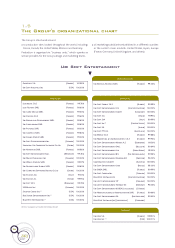Ubisoft 2002 Annual Report Download - page 45
Download and view the complete annual report
Please find page 45 of the 2002 Ubisoft annual report below. You can navigate through the pages in the report by either clicking on the pages listed below, or by using the keyword search tool below to find specific information within the annual report.
2003
45
FINANCIAL
REPORT
Accounts on March 31, 2003
In the event that business assets are valued at less than their
book value,a provision for depreciation is applied.
According to CNCC bulletin no. 123 of September 2001,
business assets must be amortized according to the same
procedures as for goodwill. Business assets are those assets
acquired or contributed since the implementation of the new
regulation 99-02. They are therefore amortized over 20 years
using the straight-line method.
Any trademarks acquired are entered at their acquisition cost.
In the case of trademarks which are created, the cost of
registering them is immobilized.
Trademarks are reviewed for each set of Annual Accounts in
the light of changes in the potential sales they generate, and
may be subject to exceptional amortization or write-down.
c.IIntangible assets
Intangible assets break down as follows:
Office software: amortized over 12 months using the
straight-line method.
Software tools:amortized over three years.
ERP-related expenditures:amortized over five years.
Sales-related software:
Software production costs are determined in accordance with
the guidelines issued by the Conseil National de la Comptabilité
(French National Accountancy Council) in April 1987.These costs
are entered in the accounts under “intangible assets” (account
no. 232) as software development progresses. From the date of
their first commercial release, they are transferred to the
"Released software" or "External developments" (account
no.208).
Parent software programs are amortized with effect from their
commercial release date on the basis of the expected market life of
the product concerned, as assessed at the account closing date.
The amortization period is between 12 and a maximum of
36 months. Net sales excluding tax of the various products until
the end of their market life are estimated at K698,425 (they
amounted to K742,652 on March 31, 2002). This sum allows the
corresponding parent software programs to be amortized. The
system of amortization used is the straight-line method.However,
if sales are less than estimated, supplementary amortization will
be carried out. Software tools, which are a set of complex
development programs that may be used for a number of
products,are amortized over a maximum of 36 months using the
straight-line method.
d.Tangible fixed assets
Tangible assets are shown in the Balance Sheet at their
acquisition cost.
Depreciation, which is calculated using rates standardized
throughout the Group, is determined on the basis of the
methods and periods of use set out below:
Equipment: 5 years (straight-line)
Fixtures and fittings: 5 and 10 years (straight-line)
Computer equipment: 3 years (diminishing balance)
Office furniture: 10 years (straight-line)
e.Financial assets
The gross value of equity holdings corresponds to the
acquisition cost or the payment in cash for the shares of
non-consolidated companies.
The value of an equity holding is reviewed at the end of each
financial year on the basis of the net position of the subsidiary
concerned on that date, the market value on the closing date
if the company is exchange listed and/or its prospects for
growth over the medium term. A provision for depreciation is
made if appropriate.
f. Fixed assets acquired through leasing arrangements
Significant capital assets which are financed by leasing
agreements are restated in the Consolidated Accounts as if the
Company had acquired the assets directly using loan finance.
g.Inventory and work-in-progress
The inventories of all Group companies are valued on the basis
of the cost prices determined under normal business
conditions. Inventory is valued using the FIFO method. The
gross value of goods and supplies includes purchase price and
related expenses. Financial costs are excluded from inventory
valuation in all cases.
A provision for depreciation is made where the probable net
realizable value is less than the book value.
h.Advances and installments paid
Licenses cover distribution and reproduction rights acquired
from other publishers.The signing of licensing contracts entails
the payment of guaranteed amounts, recorded in account
no.409.
At year-end, the amounts remaining to be amortized are
compared with sales projections. In the event that projected
sales are insufficient,additional amortization will be undertaken.
i.Trade receivables
Trade receivables are entered at their face value. Where
applicable, a provision for depreciation may be entered
according to the degree of certainty as to ultimate collection
existing at the account closing date.
j.Investment securities
Investment securities consist of directly held shares and
interests in investment funds on the one hand, and
short-term investments on the other hand, which are booked
at their purchase price or at their market value when it is
lower than the purchase price.
























